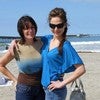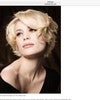Description
About This Video
Transcript
Read Full Transcript
So I thought this evening we'll do a very serious subject called the feet a because so many people have painful feet. Bunyan's hammer toes dropped, arches inflammation on the sole of the feet, heel pain, bone spurs. It's really um, a universal subject. And even though in Peloton generally we have a very holistic type of workout. Addressing the feet specifically brings huge, huge relief. And then if you spend five minutes on it first, the workout is phenomenal after that.
So most of the time people have dropped metatarsal calls and often I will have people just did really take the foot and placing this some right at the base of the metatarsal lifted up. So as they're going through the foot, they're pushing the knuckle out and stretching the toe all over the knuckles. So you get the length coming into the top of the foot. Quite often when you do this, you will get little cracks and clicks coming in. And at the beginning for quite a few people, these bones will be so dropped down, they don't come up.
So if you take the thumb and push at the bottom of the foot to force the bone up, you can literally feel it start to give and move back up. Very healthy to get the mobility back into the foot. So I will often have people to just take a minute or once they know how to do it, they start by doing this without any request to just open up the metatarsal and stretch the foot slightly. I'm not sure if you can hear my little cracks, but there they are. So the feet are beginning to get some mobility. An old, very traditional exercise was called the towel where you were. The idea was that you would use a kitchen towel, place your feet at the bottom and then literally curl your toes to pull the towel under the arch and keep going.
Let's see if I can do this. I have to go one foot at a time, crunching the toes under again. It starts to work. The metatarsal falls and works the toes, which can get quite atrophied and go as far up as you can. And I've had teachers say, you keep going until that towel is totally woopsie daisy under your foot. So I'm working here to get to the top of the towel and I think because it's a big towel, I'll start going back. So now you crunch the toes, pressing them and stretch the toes back out. So you're pushing the towel back.
And I have to say when people start out with this, they are very clumsy, disconnected, very lazy in that very distant part of the body, the toes. So it's really so therapeutic and so beneficial to wake it up. It is, stimulates the nerves throughout the whole foot and throughout the whole legs actually and starts to restore mobility and function into the whole foot. So it's crunching and pulling the towel in and pulling it out again. Then a lovely other way to start to get more stability and understanding of the motion of the foot is working with a theraband and placing it over the foot.
So you cover the toes as well. You don't want any of the material all crunched up but nice and long. Having the leg extended dow and pulling the toes backwards. So if I was to do this foot, I'm pulling the toes back with the band and then pressing the ball of the foot down, but keeping the toes coming up. So I'm doing that movement with the theraband and then extending the toes down so the toes and are working against a certain amount of resistance, pulling the toes back and extending the foot up.
So ball of the foot down, toes down, toes up, flexing the whole foot again, ball of the foot down, spreading the toes, extending them down. Only the toes come up, all of the foot lifts, and I'll do this one more time. This side, ball of the foot down, toes down, toes up. The foot comes away up. Quite challenging for a lot of people. [inaudible] again, this joint area is very stiff, rigid, they just have a feet and shoes, probably not that much with it for a long time. Wonderful for all the people. Absolutely wonderful. So doing the same thing with the other foot ball of the foot down, toes down, toes up, the whole foot flexes, ball of the foot down, toes reach out, long toes pull back and flex ball of the foot down, long in the toes, pulling the toes back, flexing the foot and last one ball of the foot down, toes down, toes up and lifting all the way out. So truth is I would probably do 10 15 repetitions per foot to get this range of movement calming back into the feet.
So if you're doing foot work, so much more stimulating, the next one was another traditional one call that was often done on a cornea, which is a two by four board or you can just do it flat. But if you had a block of wood that's elevated, maybe two inches off the floor, you have the ball of the foot on the block and then the heel is down on the frost. So you're actually in a deeper flection. And then from there you lift all the way up onto the toes as high up as you can. Keep the heels way up. And when the knees and in this place you're forcing the heel forward and you're looking to keep the heel lined up with the center of the toes, roll straight down through the foot and straighten the leg.
So the lot of attention on tracking the knees should go forward. The toes should go forward, up on the toes, bending the knees, making sure the knees are not going in, not going out. And you also look at the placement of the ankles because all sorts of funny things happen. You try to keep the heel right over the center of the foot, roll the heels straight down and back up. And again, lifting up high in the toes, bending straight through, lowering the heels. And if you have the ball of the foot slightly higher than the floor to wonderful range of movement, the foot is being asked to move through, bending the knees, rolling the heels way down and straightening up. And then you reverse it. You begin tracking straight forward, roll the heels up, making sure the heels go as high as possible over the toes, lifting straight up so the heels are nice and high and tracking the heels straight back.
Attempting to keep the knees going straight forward, bending the knees rolling forward onto the toes, lifting up, lowering down and again, bending the knees, rolling the heels up, lifting up and lowering down. Wonderful to get the foot moving to get the foot stronger. Now one of the problems that people will find very often that this joint does not bend. It should have a 90 degree angle. We are all designed to have a 90 degree angle of the toes going this way. For many people that this is become so calcified and stuck, they can barely get the toes to bend this far.
So it's a real good thing to start to get the toes moving a bit more and a way to very simply stretch them is if you place the the joint of the big toe together and walk the knees towards each other and towards the toes to get as much bend in. That part of the foot as you can and bring the heels together. So if I was to turn backwards, I've got my big joint together and then I worked to get the heels together and the knees together and sitting back and holding this position. For many people sitting that way is so excruciating that they cannot, they cannot actually take the weight back. They cannot let the toes bend, so they'll have their weight forward and that's fine. It's a good position to be in. It's a good position to spend half a minute to a minute in.
And if you can tell jokes and distract yourself or your student at the same time, that's a very good idea. If it gets better quite quickly, the body wants to let go. So after you've stayed here for half a minute to a minute, if you notice when I'm in this position, my big toe joint is bending extensively, but the little toe is often up. For most people it will be. So then you open the heels and you reach back with your hands and you pull the little toe down to the weight is into the outer foot, not the inner foot. So keeping the weight in the outer foot, sitting back one more time to encourage the bend and the motion to come back into the joint here and allow this outer line of the foot to start to open up and release Naria.
That again gets very locked up and restricted through lack of use. Just sitting here holding that and then coming out often. Then if you come back and you do the movement with this one, it will be much, much, much better because joints are now more open. So taking this to the next level, you can, you work a lot with the magic circle. The same exercise can be done with the magic circle between the ankles.
So as there is a tendency for people to pronate out or roll in, depending upon whatever the pattern in the person's foot is, if you work with the magic circle slightly, you need to stabilize a foot in the correct place against resistance. So you can work squeezing the magic circle as and and doing the whole exercise through, which gives a whole next level of interpretation to this, which is really fabulous because the feet have to work very hard. The ankles, if you give way, we'll just collapse into whatever pattern they have. So it's very strengthening and stabilizing, providing this resistance. And again, reversing, bending, rolling through working the ankle joints, it stays straight, it engages, I can feel it working all the way up through my inner thighs and calves. And again, bending, rolling through, lifting up and down. So wonderful, wonderful work to get that rounded squared correct alignment and challenge to the muscles where they need to be. So feet, ankle, joint, knees and hips are all joints.
It can eat one affect the alignment of the feet. So a nice way to work the bones of the shoe, the Shin bones is just sitting and brewing in the cin bones in the heels and bring the sin bones in, bringing the shinbone. So if you notice my foot is slightly rotating, but I'm getting the work from the very lower part of the leg that can be often deformed in different directions depending upon what the genetic pattern is that the person is working with. So heels coming in, wonderful to get the fetus start to work better. I love this. Then the next variation would be moving up to the center of the calf and again, pressing in and pressing and we're so used to all week taking all the work from the inner thigh. I can feel the inner thighs working, but the emphasis here is the shin bone down to the ankle bone engaging and clamping together. So working at it, working at it, working at it, and working it in. And then moving up from here into the inner size.
And the same thing. We're probably all familiar with this one because we do it all the time with magic circle. So it's more up in the thigh area and possibly this can be done with the heels off the ground if you're sitting to really pay attention to, to how to have this contraction of the magic circle work into the lower leg, into the ankle as well, not just the upper leg being engaged. So hand in hand with the legs going in. There's also the ability of the legs to go out or the ankles to go out of the feet to go out. So just like some people roll outwards, a lot of people will be rolled inwards and their feet collapse down and sometimes they need the strength to actually lift the art and lift the foot back up. So Tate's applying the same principle.
You can have a foot that slightly collapsed and then lift the arch and lift the arch and lift the arch and lift the arch and lift the arch. And the truth is I like to do both directions because it's stimulating both sides of the potential within the body and whatever's weak, the person knows and they can kind of get enlightenment about it, but it strengthens the whole lake, the whole ankle very nicely. Moving up to the middle of the calf, same thing again, pressing out, lifting the arch and pressing out, pressing out with the emphasis being more into the shin bone so you feel the whole leg from the knee down to the foot working, pressing out, pressing out and working up into the size. And this is a very interesting one because it allows for the thigh bones to widen the pelvis and that allows for a lot more mobility and looseness in the hip. It actually brings a lot of relief when people are very tight hips, getting the space created as you do this. So those are some of the things that can be done.
Another lovely way to get the foot to work a little better is working with the bolster. Very simply using the wall or whatever, just literally just standing on it and trying to find center of balance. It allows, the whole foot has to work. Seeing uh, uh, organizing the whole body. So your vertical and then seeing where that center of balance is and balancing there. So it can be quite fun because everything will go flying all over the place, but very strengthening and those very subtle muscles within the feet. So just having the person stand, sometimes people like to walk and roll forward and literally take a walk where they're rolling and that's the next level of this.
But just having people stand, have the arches lifted, have the body organized, so wonderful to do so. Uh, just working with a bolster, great people will usually find that their whole body feels more org, more energized and vibrant. Then we go into the traditional magic circle exercises that are done really for the whole leg, but they rely on the feet very strongly as once you have the legs contracted, the magic circle between the ankles, your lifting up on the toes and in working the inner thighs and the lift through the whole trunk. So the whole legs are engaged and you can go for a walk around the room. Fun to do because the whole leg with are activated. And I'll get back over here.
And the other thing that can be done is again, magic circle between the thighs, lifting up, pulling the inner thighs together with a nice lift, and then pulling the thigh in to work. Your innercise, finding your balance, going to the other side and pulling in. This can be done. If a person is more stable, they can be standing in the middle of the room, squeezing every time. And then working also with one leg coming in front, working the leg, pulling it in, shifting the weight, lifting up out of the hip, pulling the leg in, and then spiraling around. Same thing, lifting up again, pulling the, uh, squeezing the magic circle to work the inner size. But the ankles have to be totally stabilized to be able to do this and then see if you can rotate to the side.
I'm losing my magic circle and that's the fun of it. It slipped out, but some, if you pay attention, you can actually work the position and keep the magic circle from falling. Fabulous, fabulous work. Lots of fun to do. Toning on the feet, strengthening and on the whole legs. It's basically gone. We've gone the gamut from therapeutics, did rants and fun exercises to do, so have fun, enjoy your feet and may they bring you great joy and get you out of pain.
Thank you.
Comments
It' s very fun to walk around the room with the magic circle :D
You need to be a subscriber to post a comment.
Please Log In or Create an Account to start your free trial.



















